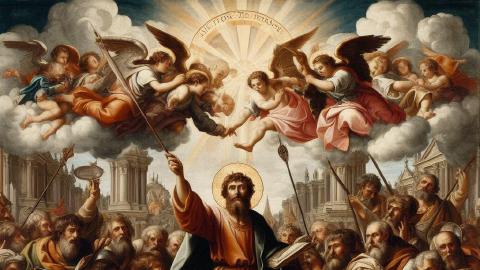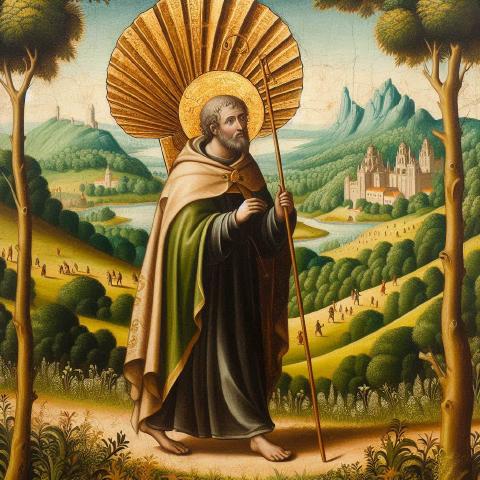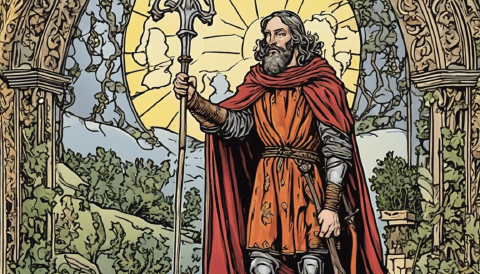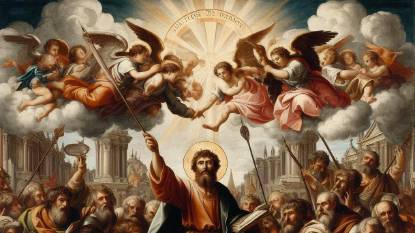
The Many Names of St James Greater and Cases of Mistaken Identity
Posted: | Updated:
Reading time: 6 minutes
The Many Names of St James Greater and Cases of Mistaken Identity
Posted: | Updated:
Reading time: 6 minutes
By: Simon Kemp , Editor
Sometimes people mix up historical figures, and St. James the Greater is no exception. Over the centuries, his image has changed depending on who was telling the story and what message they wanted to send. This has led to misunderstandings about who he was and what he represented. In this article, we’ll look at how St. James has been reimagined in different ways, how mistaken identity has shaped his legacy, and why religious symbols change over time.
The Saint of Many Names
St. James the Greater has accumulated various titles and appellations throughout history, each highlighting different aspects of his identity, veneration, and legendary exploits. These names not only reflect his importance in Christian tradition but also demonstrate how his figure has been adapted across different cultures and historical periods.
Santiago
In Spain and throughout the Spanish-speaking world, St. James is known as “Santiago,” a name derived from the Latin “Sanctus Iacobus,” which evolved through linguistic changes to “Sant Iago” and finally to “Santiago.” This name has become so synonymous with the apostle that it has lent itself to numerous cities throughout Latin America and Spain. This is the derivation of the name of the Camino de Santiago in Spanish.
Santiago Matamoros
Perhaps the most controversial title given to St. James is “Santiago Matamoros” (St. James the Moor-slayer). This warrior aspect emerged during the Spanish Reconquista, when St. James was said to have appeared miraculously at the Battle of Clavijo riding a white horse and wielding a sword against Muslim forces. This militant representation became popular in Spanish ecclesiastical art, where he is depicted on horseback trampling Moorish adversaries. In modern times, this representation has been reconsidered due to its implications of religious intolerance.
Santiago Mataindios In Latin America, particularly following the Spanish conquest, St. James acquired another military title: “Santiago Mataindios” (St. James the Indian-slayer). Spanish conquistadors claimed to have seen apparitions of St. James aiding them in battles against indigenous peoples. This adaptation of the Matamoros legend served colonial interests but has been increasingly criticized for its connection to colonial violence.

Bonaerges: Son of Thunder
Within scripture itself, Jesus gave James and his brother John the nickname “Boanerges,” meaning “Sons of Thunder” (Mark 3:17). This title reflected their zealous and impetuous temperament, demonstrated when they asked Jesus if they should call down fire from heaven upon a Samaritan village that refused to welcome them (Luke 9:54).
Jacobus Major
In Latin theological and liturgical texts, St. James is often referred to as “Jacobus Major” (James the Greater) to distinguish him from James the Less, another of the apostles. The designation “Major” or “Greater” likely stems from his prominence among the disciples rather than physical stature or age, though some traditions suggest he may have been older or taller than James the Less.
The Moorish Knight
In a curious twist of historical memory, some local Spanish legends transformed St. James into “The Moorish Knight” in certain village celebrations. This inversion of his usual role demonstrateㄚ the complex religious and cultural exchanges that occurred in medieval and early modern Spain, where Christian and Muslim cultures intermingled despite conflict.

Cases of Mistaken Identity
Throughout history, St. James the Greater has been confused with several other biblical and historical figures, leading to mixed iconography, blended stories, and occasional historical misconceptions.
James the Less
The most common confusion surrounds the distinction between James the Greater and James the Less (or James the Minor), another of Jesus’s twelve apostles. James the Less is traditionally identified as “the son of Alphaeus” mentioned in the Gospels. Unlike James the Greater, who was part of Jesus’s inner circle, James the Less had a less prominent role in the New Testament narratives.
The confusion between these two apostles has occasionally led to mixed attributions in religious art and devotional practices. In some instances, the symbols typically associated with one have been incorrectly applied to the other, particularly in local church traditions where detailed theological distinctions might not have been emphasized.
James, Brother of the Lord
Perhaps the most significant case of mistaken identity involves James, “the brother of the Lord” (Galatians 1:19), who became the leader of the Jerusalem church and is traditionally considered the author of the Epistle of James. This James—who may have been Jesus’s cousin or step-brother (depending on theological interpretation)—is usually identified with James the Less, not James the Greater.
However, throughout history, some traditions have confused or conflated these figures. In some Eastern Christian traditions, the distinctions between these different “James” figures became blurred, leading to hybrid hagiographies that combined elements from the lives of both. This confusion was sometimes compounded by translations and cultural adaptations as Christianity spread across diverse regions.
St. Iago and St. George
In medieval iconography, St. James in his Matamoros aspect (mounted on a white horse and slaying enemies) bears striking similarities to depictions of St. George slaying the dragon. This visual parallel has occasionally led to confusion between the two saints, particularly in regions where both were venerated. In some instances, churches dedicated to one saint have featured artwork more typically associated with the other.
The similarity extends to their roles as military patron saints. Just as St. James became the battle cry for Spanish forces, St. George became the patron of England and several other countries. Both saints were invoked for protection in warfare, leading to some blending of their legends in popular devotion.

The Two Apostle James and John
Another source of confusion stems from the fact that James the Greater and John the Evangelist were brothers, both sons of Zebedee. In early Christian art, before standardized iconography developed, the two brothers were sometimes depicted with similar features, leading to identification difficulties in some ancient artworks and manuscripts.
Additionally, the prominence of John in Christian tradition, particularly as the purported author of one of the Gospels and the Book of Revelation, has sometimes overshadowed James, despite James’s significance as the first apostle martyred for the faith.
James and Jacob
The name “James” itself derives from “Jacob” and is Iacobus in Latin and Iakobos or Iakovos in Greek, which has created confusion in translations and cultural adaptations. In some languages, the distinction between the biblical patriarch Jacob and the apostle James is not as clear as it is in English, leading to occasional conflation of their stories.
This linguistic connection has sometimes resulted in attributes of the patriarch Jacob being incorrectly associated with St. James, particularly in folk traditions where biblical literacy might have been limited.
Historical Implications of These Confusions
These cases of mistaken identity have had practical implications for pilgrimage and devotional practices. Some pilgrims throughout history have journeyed to Santiago de Compostela believing they were visiting the remains of James, brother of the Lord, rather than James the son of Zebedee. Similarly, prayers and invocations intended for one James have sometimes been directed to another.
While modern scholarship has clarified many of these distinctions, the historical blending of these figures demonstrates the dynamic nature of religious tradition and the ways in which saints’ identities have evolved over time to meet the spiritual and cultural needs of different communities.
For the Camino pilgrim today, understanding James’ various names and identities adds depth to the experience, revealing how the apostle venerated in Santiago de Compostela has been reimagined across centuries and cultures—becoming not just a historical figure but a multifaceted symbol adapting to the changing needs of those who walk in his honor.
St. James the Greater [Video]
Already signed up? Go to Camino Downloads!

